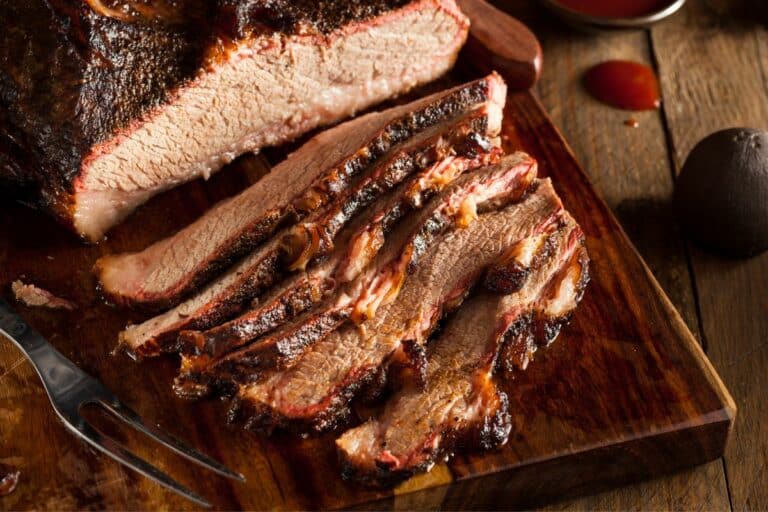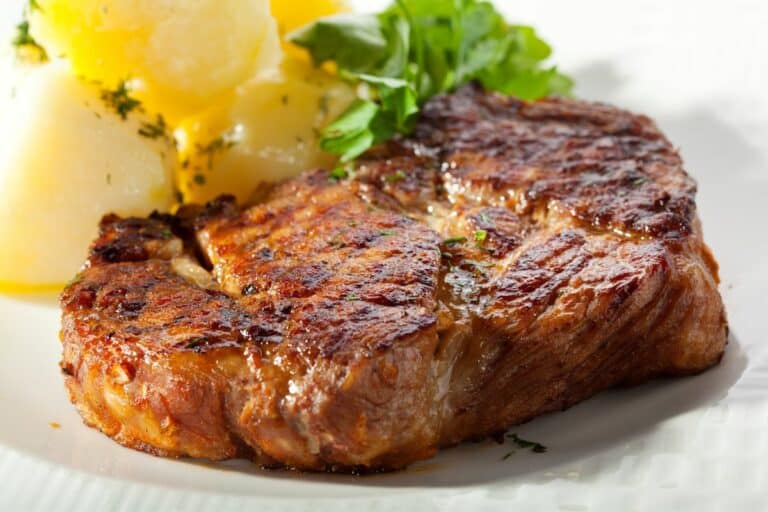Vibrant Hmong Cabbage and Chicken Ready in 40 Minutes
Discover an authentic Hmong Cabbage and Chicken stir-fry, crafted by Oliver & Natalia with over 15 years of culinary expertise, blending tender chicken with crisp vegetables.
Transparency Notice: This post contains affiliate links. We only recommend products we personally use. Learn more.
Introduction to Hmong Cuisine
Hmong cuisine is a vibrant tapestry of flavors, reflecting the culture, history, and resilience of the Hmong people. Rooted in their agrarian traditions, Hmong dishes emphasize fresh, locally sourced ingredients, resulting in healthy, flavorful meals that are both simple and profound. While lesser-known globally, Hmong food offers unique tastes and textures that captivate the palate.
Recipes like the Hmong Cabbage and Chicken recipe are often passed down through generations, carrying familial and cultural significance. This dish showcases the Hmong knack for transforming humble ingredients into delicious, nourishing meals. For more on Hmong culinary traditions, explore Hmong cuisine.
Cultural Significance
Food is central to Hmong culture, serving as a medium for family bonding and community connection. Meals are a time to gather, share stories, and express love and respect through the act of sharing. Many Hmong dishes, including this healthy Hmong dish, are prepared for festivals, weddings, and family gatherings, symbolizing unity and heritage.
The Hmong Cabbage and Chicken recipe is a beloved staple, cherished for its simplicity and bold flavors. It connects the present to the past, reflecting the Hmong people’s deep ties to their roots and their ingenuity in using available resources to create memorable meals.
Popular Ingredients
Hmong cuisine relies on fresh, natural ingredients, with vegetables like cabbage, leafy greens, and herbs taking center stage. These are often grown locally, ensuring maximum freshness and flavor. Proteins such as chicken, pork, and fish are common, typically seasoned with aromatics like garlic, ginger, and lemongrass to add depth and complexity.
Rice, a cornerstone of Hmong meals, complements the savory flavors of main dishes, providing balance and sustenance. The Hmong Cabbage and Chicken recipe exemplifies this approach, combining crisp cabbage, tender chicken, and a medley of spices for a harmonious blend of textures and tastes, making it both nutritious and satisfying.
Hmong Cabbage and Chicken Recipe
Ingredients
Fresh Vegetables
| Quantity | Ingredient | Preparation |
|---|---|---|
| 3 cups | Cabbage | Shredded |
| 1 cup | Carrots | Thinly sliced |
| 1 large | Onion | Sliced |
| 3 cloves | Garlic | Minced |
| 1 bunch | Green onions | Chopped |
| 1 cup | Bell peppers | Sliced (optional) |
Essential Spices and Seasonings
| Quantity | Ingredient | Preparation |
|---|---|---|
| 1 tsp | Salt | – |
| 1/2 tsp | Black pepper | – |
| 2 tbsp | Fish sauce | – |
| 2 tbsp | Soy sauce | – |
| 1 tbsp | Lemongrass | Minced (optional) |
| 2-3 | Chili peppers | Chopped (optional) |
Chicken Selection
| Quantity | Ingredient | Preparation |
|---|---|---|
| 1 lb | Chicken breast or thighs | Boneless, skinless, diced |
| 1 tbsp | Vegetable oil (or sesame oil) | For cooking |
| 1 tbsp | Minced ginger | For marinade |
| 1 tbsp | Lime juice | For finishing |
Instructions
- Marinate Chicken: In a bowl, combine 1 lb diced chicken with 2 tbsp soy sauce, 1 tbsp minced garlic, 1 tbsp minced ginger, and 1/2 tsp black pepper. Mix well to coat evenly, then cover and refrigerate for at least 30 minutes (or up to 2 hours for deeper flavor).
- Sauté Cabbage: Heat a large skillet or wok over medium heat with 1 tbsp vegetable oil. Add 3 cups shredded cabbage and stir frequently, cooking for 5-7 minutes until tender but slightly crisp. Add 1 tsp salt, 1/2 tsp black pepper, 1 tbsp fish sauce, and 1 tbsp soy sauce, stirring to coat evenly. Cook for 1-2 minutes to meld flavors.
- Sear Chicken: In another skillet or wok, heat 1 tbsp vegetable oil (or sesame oil) over medium-high heat. Add the marinated chicken in a single layer and sear for 4-5 minutes per side until golden brown and slightly crispy. Add 1/2 cup chicken broth or water, reduce heat to medium-low, cover, and simmer for 10-15 minutes until the chicken reaches 165°F (74°C).
- Combine Ingredients: In the skillet with the cabbage, add the seared chicken, 1 cup thinly sliced carrots, 1 large sliced onion, and 1 cup sliced bell peppers (if using). Gently toss over medium heat for 3-5 minutes to combine. Add 1 tbsp fish sauce, 1 tbsp soy sauce, and 1 tbsp lime juice, stirring to coat evenly. Adjust seasoning with additional salt, pepper, or chili peppers (2-3 chopped, optional).
- Serve: Serve hot, garnished with chopped green onions or cilantro, alongside steamed rice, fresh spring rolls, or a simple salad from our Salads collection.
Preparation Tips
Chopping Techniques
Begin by thoroughly washing the cabbage under cold water, removing any wilted or damaged outer leaves. Shred the cabbage into thin, uniform strips to ensure even cooking and a pleasant texture. For more on cabbage preparation, see Cabbage.
For the chicken, use boneless, skinless breasts or thighs and cut into bite-sized chunks using a sharp knife for clean, precise cuts. Slice carrots thinly, chop onions and bell peppers into strips, mince garlic finely, and chop green onions for garnish. Use separate cutting boards for vegetables and meat to avoid cross-contamination, ensuring hygiene and flavor integrity.
Marinating the Chicken
Marinating the chicken enhances its flavor and tenderness. In a bowl, combine 1 lb diced chicken with 2 tbsp soy sauce, 1 tbsp minced garlic, 1 tbsp minced ginger, and 1/2 tsp black pepper. Mix well to coat evenly, then cover and refrigerate for at least 30 minutes (or up to 2 hours for deeper flavor). This step infuses the chicken with savory, aromatic notes, ensuring it pairs perfectly with the crisp cabbage.
Cooking the Chicken
Perfect Searing
Heat a large skillet or wok over medium-high heat and add 1 tbsp vegetable oil (or sesame oil for extra flavor). Once the oil is shimmering, add the marinated chicken pieces in a single layer, avoiding overcrowding to ensure proper searing. Cook for 4-5 minutes per side until golden brown and slightly crispy, using tongs to flip. Use a meat thermometer to confirm the internal temperature reaches 165°F (74°C) for safety. Work in batches if necessary, adding more oil as needed.
Maintaining Juiciness
After searing, reduce the heat to medium-low and add 1/2 cup chicken broth or water to the skillet to create steam, keeping the chicken moist. Cover with a lid and simmer for 10-15 minutes, allowing the chicken to cook through gently while retaining its juices. Alternatively, for a hands-off approach, transfer seared chicken to a slow cooker with 1/2 cup broth and cook on low for 4-6 hours for ultra-tender results.
Let the chicken rest for 5 minutes before combining with the cabbage, allowing the juices to redistribute for maximum tenderness. This step ensures every bite is moist and flavorful.
Preparing the Cabbage
Sautéing Methods
Wash the cabbage thoroughly, removing any tough outer leaves, and shred into thin slices for even cooking. Heat a large skillet or wok over medium heat with 1 tbsp vegetable oil. Once hot, add 3 cups shredded cabbage and stir frequently, cooking for 5-7 minutes until tender but still slightly crisp. Avoid overcooking to preserve the cabbage’s texture and natural sweetness.
Seasoning the Cabbage
Season the cabbage to enhance its flavor. Add 1 tsp salt and 1/2 tsp black pepper, stirring to coat evenly. For an authentic Hmong touch, incorporate 1 tbsp fish sauce and 1 tbsp soy sauce, adding umami depth. Include 1 tsp minced garlic or 1/2 tsp garlic powder for aromatic richness. Cook for 1-2 minutes to meld the flavors, tasting and adjusting seasoning as needed. The cabbage is now ready to combine with the chicken.
Combining Ingredients
Mixing Techniques
In the same skillet or wok used for the cabbage, add the seared chicken back to the pan with the sautéed cabbage. Include 1 cup thinly sliced carrots, 1 large sliced onion, and 1 cup sliced bell peppers (if using) for added color and crunch. Gently toss over medium heat for 3-5 minutes to combine, ensuring the ingredients are evenly distributed. This method blends the textures and flavors while keeping the vegetables crisp.
Balancing Flavors
To balance the dish, add 1 tbsp minced garlic and 1 tbsp minced ginger for a zesty kick, enhancing the chicken’s savory profile. Pour in 1 tbsp fish sauce and 1 tbsp soy sauce for umami depth, stirring to coat evenly. For a fresh, tangy finish, squeeze in the juice of half a lime (about 1 tbsp). Taste and adjust with additional salt, pepper, or chili peppers (2-3 chopped, optional) for heat. This careful balancing ensures a vibrant, well-rounded flavor in every bite.
Serving Suggestions
Ideal Side Dishes
Pairing this authentic Hmong recipe with complementary sides creates a balanced, satisfying meal. Consider these options:
- Steamed Rice: Fluffy jasmine or sticky rice soaks up the savory juices, complementing the stir-fry’s flavors.
- Fresh Spring Rolls: Filled with herbs and vegetables, these add a refreshing crunch and pair well with a dipping sauce.
- Stir-Fried Vegetables: A mix of broccoli, snap peas, or zucchini adds color and nutrients.
- Simple Salad: A light Crispy Chicken Salad with a tangy dressing balances the dish’s richness.
Presentation Tips
Elevate the visual appeal of your dish with these presentation tips:
- Use a Large Plate: A wide, white plate showcases the dish’s vibrant colors and looks elegant.
- Garnish with Fresh Herbs: Sprinkle chopped cilantro or green onions on top for a pop of color and freshness.
- Arrange Neatly: Place chicken pieces atop the cabbage for a clean, appetizing presentation.
- Serve Sides in Small Bowls: Keep the stir-fry as the focal point by serving sides in separate, small dishes.
A well-presented dish enhances the dining experience, making it as delightful to the eyes as it is to the palate.
Health Benefits of Hmong Cabbage and Chicken Dish
Nutritional Value
Cabbage is a low-calorie vegetable packed with essential nutrients. It’s an excellent source of vitamin C (supports immune health), vitamin K (promotes bone health), and dietary fiber (aids digestion). For more on cabbage’s benefits, see Healthline.
Chicken provides high-quality lean protein, crucial for muscle repair and overall body function. It’s also rich in B vitamins (like B6 for metabolism) and selenium (an antioxidant for cell protection). Together, these ingredients create a balanced, nutrient-dense meal that supports overall wellness.
Dietary Considerations
This dish is versatile for various dietary needs. It’s naturally low in carbohydrates, making it suitable for low-carb or keto diets. The recipe is also gluten-free when using gluten-free soy sauce and fish sauce, ideal for those with gluten sensitivities (see our Gluten-Free Meal Plans).
For a lighter option, use skinless chicken breast to reduce fat and calories. Adjust seasoning to lower sodium by using low-sodium soy sauce or reducing fish sauce. These adaptations make the dish customizable without sacrificing flavor.
Variations and Tips
Vegetarian Option
Replace chicken with firm tofu or tempeh for a plant-based version. Marinate and cook the tofu similarly to absorb the savory flavors, pairing it with the cabbage and vegetables for a hearty, protein-rich dish.
Spicy Variation
For a fiery kick, increase the chili peppers to 4-5 or add 1 tsp chili oil during cooking. Incorporate 1/2 tsp red pepper flakes for extra heat, balancing with a splash of lime juice to maintain flavor harmony.
Cooking Tips
- Prep Ahead: Chop vegetables and marinate chicken in advance to save time. Store prepped ingredients in airtight containers in the refrigerator for up to 24 hours.
- High Heat for Stir-Fry: Use a wok or large skillet on medium-high heat to achieve a quick sear and preserve vegetable crispness.
- Taste and Adjust: Sample the dish before serving, adjusting with soy sauce, fish sauce, or lime juice to perfect the flavor balance.








